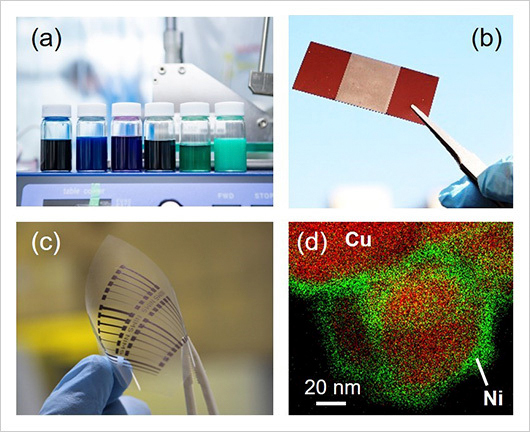 Press Release 2022
Press Release 2022
Development of an Oxidation-Resistant Copper Core–Nickel Shell Ink
Priways Co., Ltd.
The National Institute for Materials Science (NIMS) has developed a new conductive ink for use in printed electronics with significantly improved resistance to oxidation.
“Self-Organizing, Environmentally Stable, and Low-Cost Copper-Nickel Complex Inks for Printed Flexible Electronics”
Wanli Li, Lingying Li, Fei Li, Kohsaku Kawakami, Qingqing Sun, Tomonobu Nakayama, Xuying Liu, Masayuki Kanehara, Jie Zhang, and Takeo Minari;
Journal: ACS Applied Materials & Interfaces [February 1, 2022];
DOI : 10.1021/acsami.1c21633

Figure. (a) Inks composed of copper and nickel complexes. (b, c) Copper–nickel alloys printed on a polyimide film (b) and a transparent film (c). (d) SEM mapping image of a copper core–nickel shell nanostructure.
Abstract
Silver nanoparticle inks are currently the most commonly used in printed electronics. However, these inks are expensive and poorly compatible with soldering. Copper nanoparticle inks have been considered a viable, cheaper alternative, although they are extremely susceptible to oxidation, making them unsuitable for use in printed electronics. Development of more stable and economical inks had therefore been anticipated.
A NIMS research team focused on inks composed of complexes of organic amine ligands with a central metallic ion because they are stable in the air. The team subsequently discovered that inks containing a mixture of different metallic complexes are capable of converting into different types of printed metallic patterns, including multilayered core–shell nanostructures and alloys, depending on the ink’s composition and other conditions. Based on these findings, the team developed an ink composed of a mixture of copper and nickel complexes able to self-organize into a copper core–nickel shell nanostructure. Because its outer nickel layer is resistant to oxidation, this printed pattern is significantly more resistant to oxidation than patterns printed using conventional copper inks. The new ink is also cheaper than the currently available silver nanoparticle inks. Moreover, the electrical resistivity of conductive patterns printed using this ink was no more than 19 μΩcm, indicating that the conductivity of these patterns is comparable to patterns printed using conventional metallic inks.
The addition of fine copper powder to this ink is expected to increase its ability to form thicker layers. The team is currently designing this new ink formulation in collaboration with the developers of the copper powder: Sumitomo Metal Mining Co., Ltd. and Priways Co., Ltd. These companies plan to release sample ink products in the near future.
This project was carried out by a research team consisting of Takeo Minari (Group Leader, Research Center for Functional Materials (RCFM), NIMS), Wanli Li (Postdoctoral Researcher, RCFM, NIMS; currently Associate Professor, Jiangnan University), Kohsaku Kawakami (Group Leader, RCFM, NIMS), Tomonobu Nakayama (Deputy Director, International Center for Materials Nanoarchitectonics (MANA), NIMS) and Lingying Li (a recipient of the JSPS Research Fellowship for Young Scientists, MANA, NIMS).
This research was published in the online version of ACS Applied Materials & Interfaces on February 1, 2022.
(Regarding this research)
Takeo Minari
Group Leader
Printed Electronics Group
Research Center for Functional Materials
National Institute for Materials Science
Tel: +81-29-860-4918
E-Mail: MINARI.Takeo=nims.go.jp
(Please change "=" to "@")
Hayato Kawashima
CEO, Priways Co., Ltd.
E-Mail: info=priways.co.jp
(Please change "=" to "@")
(General information)
Public Relations Office
National Institute for Materials Science
Tel: +81-29-859-2026
Fax: +81-29-859-2017
E-Mail: pressrelease=ml.nims.go.jp
(Please change "=" to "@")

